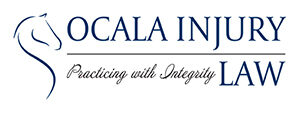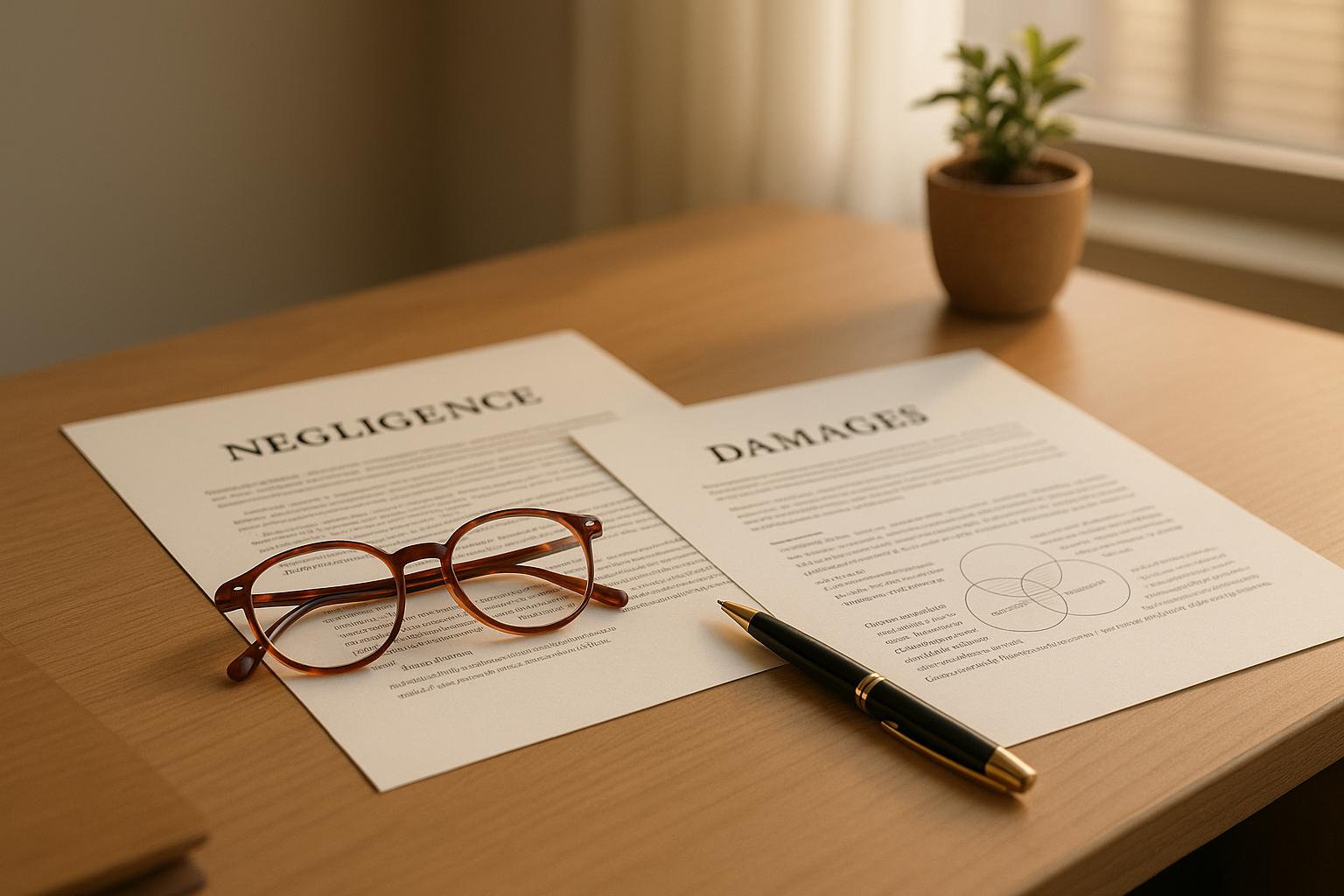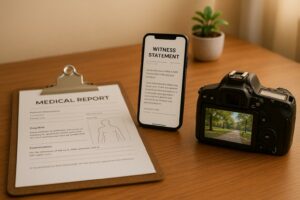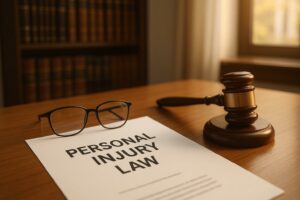Navigating personal injury cases can feel overwhelming, especially with all the legal terms involved. Here’s a simplified overview of 10 key terms to help you better understand your case and make informed decisions:
- Negligence: When someone’s carelessness causes harm. Proving this requires showing duty of care, breach, causation, and damages.
- Damages: These include economic (e.g., medical bills, lost wages) and non-economic (e.g., pain and suffering) losses.
- Statute of Limitations: Deadlines for filing claims, usually 2 years in many states like Florida.
- Legal Liability: Responsibility for harm caused, which can be direct, vicarious, strict, or premises liability.
- Causation: Linking the defendant’s actions to the injury through evidence like medical records or witness statements.
- Plaintiff & Defendant: The injured party filing the lawsuit (plaintiff) and the party being sued (defendant).
- Burden of Proof: The plaintiff must prove their case is more likely true than not (preponderance of evidence).
- Comparative Negligence: Your compensation may be reduced based on your share of fault in the accident.
- Contingency Fees: Most personal injury lawyers only get paid if you win, typically taking 33-40% of the settlement.
- Legal Settlements: Most cases end in settlements, which include compensation for damages and a release of future claims.
Quick Comparison
| Legal Term | Definition | Key Example |
|---|---|---|
| Negligence | Carelessness causing harm | Store owner ignores a spill, causing a slip and fall |
| Damages | Financial and emotional losses from injury | Medical bills, lost wages, or pain and suffering |
| Statute of Limitations | Deadline for filing a claim | 2 years for personal injury in Florida |
| Legal Liability | Responsibility for harm caused | Employer liable for employee’s negligence |
| Causation | Linking defendant’s actions to injury | Wet floor directly causing a slip and fall |
| Plaintiff & Defendant | Injured party (plaintiff) vs. party being sued (defendant) | Victim sues a distracted driver for injuries |
| Burden of Proof | Plaintiff must prove case is more likely true than not | Evidence like medical records or accident photos |
| Comparative Negligence | Reduces compensation based on plaintiff’s fault | 30% fault = $70,000 recovery from $100,000 damages |
| Contingency Fees | Lawyer gets paid only if you win | 33-40% of settlement, no upfront costs |
| Legal Settlements | Agreement to resolve the case without trial | $100,000 settlement covering medical bills and lost wages |
1. What is Negligence?
Negligence plays a key role in personal injury cases. It happens when someone’s carelessness, rather than deliberate actions, leads to harm.
To prove negligence, four essential elements must be established:
- Duty of Care: The responsible party had an obligation to act in a reasonable manner.
- Breach of Duty: They failed to meet that obligation.
- Causation: Their failure directly caused the injury.
- Damages: The injury resulted in measurable losses.
To clarify how negligence differs from other harmful actions, take a look at this table:
| Type of Action | Definition | Example |
|---|---|---|
| Negligence | Unintentional harm caused by not exercising reasonable care | A store owner not cleaning up a spill, causing a slip and fall |
| Intentional Harm | Deliberate actions aimed at causing injury | Purposefully pushing someone down a flight of stairs |
| Pure Accident | An unavoidable incident where no one is at fault | A tree falling during a storm, despite proper upkeep |
Understanding negligence is critical for collecting evidence and building a strong case.
Up next, explore the types of damages you can pursue in a personal injury claim.
2. Types of Damages: Economic and Non-Economic
In personal injury cases, damages fall into two categories: economic and non-economic.
Economic Damages
These are measurable financial losses tied directly to the injury. Examples include:
- Medical bills (both past and future expenses)
- Lost wages or reduced earning capacity
- Costs to repair or replace damaged property
- Rehabilitation expenses
- Transportation costs for medical care
- Home modifications needed for accessibility
Non-Economic Damages
These damages cover the intangible effects of an injury, such as:
- Physical pain and suffering
- Emotional distress
- Loss of enjoyment in daily life
- Strained or lost relationships (loss of consortium)
- Permanent scarring or disfigurement
- Mental anguish
Comparing Economic and Non-Economic Damages
| Damage Type | How It’s Calculated | Documentation Needed |
|---|---|---|
| Economic | Adds up bills, receipts, and wages | Medical bills, pay stubs, tax returns |
| Non-Economic | Uses the multiplier or per diem method | Medical records, expert opinions |
Example Breakdown
Let’s say someone slips and falls. They could face:
- Economic damages: $50,000 for medical treatment, $20,000 in lost wages, and $5,000 for physical therapy.
- Non-economic damages: Chronic pain that disrupts daily life and relationships.
When combined, these damages aim to address the full scope of the injury’s impact. Up next, we’ll explore the deadlines for filing claims.
3. Time Limits for Filing Claims
The statute of limitations imposes a strict deadline for filing claims. In most states, including Florida, the window to file is typically two years, making it crucial to act quickly.
Standard Time Limits by Case Type
| Case Type | Typical Deadline | Special Requirements |
|---|---|---|
| General Personal Injury | 2 years | None |
| Medical Malpractice | 1–3 years | May require pre-suit notice |
| Product Liability | 2–3 years | Documentation of product defect required |
| Wrongful Death | 2 years | Starts from the date of death |
| Government Claims | 60–180 days | Requires formal notice of claim |
Exceptions That Can Extend Deadlines
Certain exceptions may give you more time to file. For instance, the discovery rule allows the clock to start when you first become aware of your injury. Other exceptions include delays for minors, mental incapacity, or when the defendant is out of state.
Why Deadlines Are Strictly Enforced
Courts take filing deadlines seriously. Missing the deadline usually means your claim will be permanently dismissed, leaving no room for legal recourse.
Filing Deadlines by State
Time limits differ depending on the state you’re in. Here’s a quick breakdown:
- One-year states: Kentucky, Louisiana, Tennessee
- Two-year states: California, Florida, Illinois, Ohio
- Three-year states: Maryland, Massachusetts, New York
- Four-year states: Utah
- Six-year states: Maine, North Dakota
Steps to Protect Your Claim
To ensure your rights are preserved, take these steps without delay:
- Document the date of your injury to establish a clear timeline.
- Seek medical attention immediately to link your injury to the incident.
- Consult an attorney as soon as possible to avoid costly delays.
- Keep detailed records of all injury-related expenses and events.
- Understand that settlement negotiations don’t stop the clock – the deadline still applies.
It’s worth noting that claims against government entities often have much shorter deadlines, so extra caution is required. With these time limits in mind, the next step is understanding how legal liability works in personal injury cases.
4. Understanding Legal Liability
Legal liability refers to the responsibility for harm caused by someone’s actions – or lack of action. Establishing liability is a cornerstone of personal injury cases, as it identifies who is responsible for the damages a victim has experienced.
Types of Legal Liability
Liability can take several forms, each with specific applications. Here’s a quick overview:
| Type | Description | Common Examples |
|---|---|---|
| Direct Liability | When a person is directly responsible for causing harm | A driver texting behind the wheel and causing an accident |
| Vicarious Liability | Responsibility for someone else’s actions | An employer being held accountable for an employee’s negligence |
| Strict Liability | Responsibility regardless of fault or intent | Injuries caused by a faulty product |
| Premises Liability | Related to unsafe conditions on a property | A customer slipping on a wet floor in a store |
Four Elements of Liability
For liability to be established, four key elements must be proven:
- Duty of Care
The defendant must have had a legal obligation to act in a way that avoids causing harm to others. - Breach of Duty
Evidence must show that the defendant failed in their duty. For instance, a landlord ignoring a damaged staircase could qualify as a breach. - Causation
There must be a clear link between the breach of duty and the harm suffered. This includes both direct cause and whether the harm was a foreseeable result of the breach. - Damages
The harm must be measurable, such as medical expenses, lost income, emotional distress, or property damage.
Shared Responsibility
In many states, the concept of comparative negligence is applied. This means that if the plaintiff is partially at fault, their compensation is adjusted accordingly. For example, in a pure comparative negligence system, if a plaintiff is found to be 30% at fault for an accident, a $100,000 settlement would be reduced to $70,000. This approach ensures fairness by considering the actions of all parties involved.
Insurance and Liability
Insurance companies play a significant role in liability cases. They typically:
- Investigate the incident to determine fault
- Offer legal representation for their policyholders
- Negotiate settlements with the injured party
- Establish coverage limits that cap compensation
Key Factors and Common Defenses
Several factors influence liability decisions, including the timing of the incident, available evidence, documented injuries, pre-existing conditions, and the specific laws of the state where the incident occurred. Defendants often rely on the following defenses:
- Force majeure: Events outside human control, like natural disasters
- Assumption of risk: The plaintiff knowingly accepted potential risks
- Pre-existing conditions: Arguing that injuries were not caused by the incident
- Statute of limitations: Claiming the lawsuit was filed too late
- Lack of causation: Challenging the connection between the breach and the harm
Up next: how to meet the burden of proof needed to strengthen your case.
5. Proving Causation
Causation is the critical link between a defendant’s actions and a plaintiff’s injuries. In personal injury cases, proving causation involves demonstrating two essential elements: actual cause and proximate cause.
Understanding the Two Types of Causation
| Type | Definition | Example |
|---|---|---|
| Actual Cause | Examines whether the injury would have occurred "but for" the defendant’s actions. | A driver running a red light and causing a collision. |
| Proximate Cause | Focuses on whether the injury was a foreseeable outcome of the defendant’s actions. | A wet floor causing someone to slip and fall. |
The "But-For" Test
The "but-for" test is a straightforward way to evaluate actual cause. Ask yourself: Would the injury have happened but for the defendant’s actions? For example, if a store fails to clean up a spill and a customer slips, the spill is the direct cause of the injury.
Building Your Case
To establish causation, you’ll need solid evidence that connects the defendant’s actions to the injury. This includes:
- Medical Documentation: Records that directly link the injuries to the incident.
- Expert Testimony: Insights from medical professionals who can explain how the injuries resulted from the event.
- Physical Evidence: Photos, videos, or accident reports that outline what happened.
- Witness Statements: Firsthand accounts from people who saw the incident unfold.
In personal injury law, the burden of proof is based on a "preponderance of the evidence", meaning it’s more likely than not (over 50%) that the defendant’s actions caused the injury.
Special Rules: The "Eggshell Plaintiff"
The "eggshell plaintiff" rule states that defendants must accept plaintiffs as they are. If a plaintiff has a pre-existing condition that worsens their injuries, the defendant is still responsible for the full extent of the harm caused.
Challenges in Proving Causation
Proving causation can get tricky due to factors like:
- Pre-existing Conditions: Defendants might argue that the injuries existed before the incident.
- Time Gaps: Delays between the incident and the appearance of symptoms can complicate the case.
- Multiple Causes: When several factors contribute to the injury, it may be harder to pinpoint responsibility.
- Intervening Events: Other incidents occurring after the defendant’s actions might muddy the waters.
These challenges highlight the need for strong, clear evidence to make a compelling case.
Tackling Complex Cases
Some cases require specialized expertise to establish causation:
- Medical Malpractice: Often needs testimony from healthcare professionals.
- Product Liability: May involve engineers or safety experts to analyze defective products.
- Toxic Exposure: Relies on scientific data and expert analysis.
- Car Accidents: Could benefit from accident reconstruction specialists.
Up next, we’ll dive into the roles and responsibilities involved in meeting the burden of proof.
6. Who are Plaintiffs and Defendants?
In personal injury cases, it’s crucial to understand the roles of the two main parties involved: the plaintiff and the defendant. Here’s a quick breakdown:
| Party | Role |
|---|---|
| Plaintiff | The person who files the lawsuit. |
| Defendant | The individual or entity being sued. |
These roles define the responsibilities and actions each party will take throughout the legal process.
sbb-itb-68ed374
7. Meeting the Burden of Proof
After discussing causation, the next step in personal injury cases is understanding the "burden of proof."
In these cases, the burden of proof falls on the plaintiff, who must demonstrate that the defendant’s negligence directly caused their injuries. Unlike criminal cases, which require proof "beyond a reasonable doubt", personal injury cases use a less stringent standard called the "preponderance of the evidence." This means the plaintiff must show that their claim is more likely true than not.
| Standard of Proof | Certainty Level | Type of Case |
|---|---|---|
| Preponderance of Evidence | Greater than 50% | Personal Injury |
| Beyond Reasonable Doubt | Nearly 100% | Criminal |
| Clear and Convincing | About 75% | Some Civil Cases |
To meet this standard, plaintiffs need to present compelling evidence, such as:
- Medical records documenting injuries
- Expert witness testimony offering professional insights
- Accident reports and photographs detailing the incident
- Witness statements supporting the plaintiff’s account
- Documentation of damages, including bills and proof of lost wages
Failing to meet this burden means the plaintiff cannot recover compensation, no matter how severe their injuries might be. This highlights why gathering strong evidence and having skilled legal representation is critical from the very beginning.
For example, in a car accident case, evidence might include police reports, medical records, photographs of the accident scene, expert testimony, and eyewitness accounts. Each piece of evidence plays a role in establishing that the defendant’s negligence caused the injuries.
Defendants, on the other hand, may present affirmative defenses, such as contributory negligence, but they must also back their claims with evidence. This means the plaintiff must consistently meet the required standard throughout the case.
Partnering with experienced legal professionals, like Ocala Injury Law (https://ocalainjurylaw.com), ensures that critical evidence is properly collected, preserved, and presented to meet this legal requirement.
Next, we’ll dive into how comparative negligence factors into personal injury cases.
8. How Comparative Negligence Works
Understanding comparative negligence is essential when determining how much you can recover after an accident. It directly ties your compensation to your percentage of fault in the incident.
Here’s a simple breakdown: under Florida’s modified comparative negligence system, your recovery amount is reduced by your share of the fault. For instance, if the total damages are $100,000 and you’re found to be 30% at fault, you’d recover $70,000.
Here’s how compensation works under different negligence systems:
| Negligence System | Recovery Threshold | Example Compensation ($100,000 case) |
|---|---|---|
| Pure Comparative | Any percentage of fault | 80% fault results in a $20,000 recovery |
| Modified Comparative (FL) | 50% or less fault | 30% fault = $70,000 recovery |
| Modified Comparative (FL) | Over 50% fault | No recovery allowed |
Insurance adjusters typically investigate accidents to assign fault percentages. Their goal? Often, to increase your share of fault and reduce the payout. However, these percentages can be challenged with strong evidence like:
- Accident reports and photos
- Witness statements
- Expert testimony
- Medical records
- Video footage (if available)
Florida law recently tightened its rules. Starting in 2024, you can only recover damages if your fault is 50% or less. This makes it even more critical to understand how comparative negligence works and to protect your rights.
Here are some steps to safeguard yourself:
- Document everything right after the incident
- Avoid making statements that admit fault
- Gather contact information from witnesses
- Seek medical attention promptly
- Speak with an attorney before dealing with insurers
If you’re navigating a comparative negligence case, knowing your rights and building a strong case can make all the difference. Ocala Injury Law can help evaluate your situation and work to minimize your fault percentage, increasing your potential compensation.
9. Attorney Contingency Fees
Contingency fees mean you only pay your attorney if you receive compensation. Instead of charging hourly or requiring upfront payments, the attorney takes a percentage of your final settlement or court award.
Here’s a breakdown of how contingency fees usually work:
| Settlement Stage | Standard Fee Percentage | Example on $100,000 Recovery |
|---|---|---|
| Pre-lawsuit Settlement | 33.33% | $33,330 |
| After Filing Lawsuit | 40% | $40,000 |
| Complex Cases/Appeals | May exceed 40% | Varies based on complexity |
Most personal injury firms also cover related costs upfront, such as:
- Court filing fees
- Expert witness fees
- Medical record retrieval
- Investigation expenses
- Deposition costs
This approach allows your case to move forward without requiring you to pay these expenses out of pocket. Typically, these costs are deducted from your settlement before calculating the attorney’s fee. For instance, if your case settles for $100,000 and there are $5,000 in expenses, the attorney’s percentage is applied to the remaining $95,000.
A survey by the American Bar Association found that about 75% of personal injury attorneys primarily use contingency fee arrangements. This structure makes legal representation accessible to those who might not otherwise afford it, aligning the attorney’s success with your own – they only get paid if you win.
When discussing contingency fees, keep these points in mind:
- Get the agreement in writing to avoid misunderstandings.
- Understand how expenses are handled, including what happens if your case doesn’t settle.
- Clarify fee increases, especially if your case progresses to trial or appeals.
- Ask about fee calculations in cases involving multiple defendants.
- Discuss how medical liens and other claims will be resolved from your settlement.
In some cases, attorneys may adjust their rates for straightforward claims or those with significant settlement potential. It’s worth discussing fee structures during your initial consultation.
At Ocala Injury Law, for example, the firm charges 33.33% for pre-litigation settlements and 40% for cases that go to court, covering all related expenses upfront so you face no initial costs.
Understanding contingency fees is an essential step before diving into the legal settlement process. It ensures you know what to expect and how your attorney’s interests align with yours.
10. Legal Settlements
In personal injury cases, most disputes – around 95% – are resolved through settlements rather than going to trial. Settlements provide a sense of closure and certainty, sparing both parties the time, cost, and unpredictability of a courtroom battle.
A settlement typically includes the following key elements:
| Component | Description | Purpose |
|---|---|---|
| Monetary Compensation | The agreed payment amount | Covers medical expenses, lost wages, and other damages incurred |
| Release of Claims | Agreement to waive future lawsuits | Prevents additional legal actions related to the incident |
| Payment Terms | How and when funds are distributed | Outlines the method and timeline for receiving the settlement amount |
| Confidentiality | Privacy requirements | May restrict public discussion of the settlement’s terms and details |
These components ensure the settlement process is straightforward and efficient. When evaluating an offer, it’s important to consider both your current needs and any future expenses. For instance, if you’ve sustained a permanent injury that requires ongoing care, a structured settlement with periodic payments might be more suitable than a one-time lump sum.
Several factors influence the value of a settlement, including:
- The severity and long-term impact of your injuries
- Current and anticipated medical costs
- Lost income and reduced earning potential
- Compensation for pain and suffering
- The strength of evidence proving fault
- The limits of the available insurance coverage
Once both sides agree on the terms, the settlement process usually takes about 2 to 6 weeks to complete. During this time, your attorney will handle several key tasks:
- Finalizing and reviewing all settlement documents
- Resolving any liens or claims against your settlement
- Ensuring funds are properly distributed
- Filing necessary dismissal paperwork with the court
Before accepting a settlement, keep these points in mind:
- Avoid accepting the initial offer without thorough evaluation.
- Factor in future medical and living expenses.
- Understand that settlements are final – there’s no going back.
- Carefully review all terms and conditions before signing.
- Confirm how any medical liens will be resolved.
At Ocala Injury Law, settlements are designed with your best interests in mind. Every agreement is carefully structured to address both immediate and long-term needs, ensuring you receive fair compensation without enduring a lengthy court battle. With this approach, clients can move forward with confidence, knowing their future is secure.
Next Steps
Getting familiar with personal injury terms can make a big difference in how you approach your case. These terms directly influence how your claim is managed, evaluated, and ultimately resolved. For instance, understanding the distinction between economic and non-economic damages can help you determine whether a settlement offer fairly addresses both your medical expenses and the pain you’ve endured.
Here’s a quick look at how some of these legal terms play a role in your case:
| Legal Term | Impact on Your Case | Why It Matters |
|---|---|---|
| Negligence | Determines liability | Impacts your ability to recover compensation |
| Damages | Influences compensation | Helps calculate a fair settlement value |
| Statute of Limitations | Sets filing deadlines | Missing it could prevent you from recovering damages |
| Comparative Negligence | Affects recovery amount | May reduce your compensation based on your fault |
Understanding these terms is just the starting point – it’s a foundation for making informed decisions and seeking professional advice.
"At Ocala Injury Law, we pride ourselves on providing personalized attention and dedicated service. Our boutique approach ensures that every client receives the care and expertise they deserve."
Seeking legal guidance can make a significant difference. A skilled attorney can:
- Break down complex legal terms and explain how they apply to your case
- Ensure you meet all legal requirements and deadlines
- Help you pursue the maximum compensation possible
Don’t let confusion about legal jargon hold you back from pursuing justice. Working with an experienced attorney can help you navigate these challenges with confidence.
Every personal injury case is unique, and how these legal terms apply will depend on your specific situation. By consulting with knowledgeable professionals, you can better understand your options and take meaningful steps toward a favorable resolution. Schedule a free consultation today to get started.
FAQs
How can I tell if I have a valid personal injury claim due to someone else’s negligence?
To figure out if you have a valid personal injury claim due to negligence, there are three main elements that need to be proven:
- Duty of Care: The person or organization had a responsibility to act in a way that ensured your safety. For example, drivers are expected to follow traffic laws to protect others on the road.
- Breach of Duty: They failed to uphold that responsibility through careless or reckless behavior.
- Damages: Their actions caused your injury, resulting in measurable consequences like medical expenses, lost income, or physical and emotional suffering.
If you’re uncertain about whether your situation meets these requirements, it’s worth speaking with a personal injury attorney. At Ocala Injury Law, we provide free consultations to help you understand your legal options and determine if you have a case.
Can I still file a personal injury claim if I was partially at fault for the accident?
Yes, you can often still file a personal injury claim even if you were partially at fault for the incident. Many states use a system called comparative negligence, which means your ability to recover damages depends on your share of the fault. For instance, if you’re determined to be 20% at fault, your compensation would typically be reduced by that same 20%.
Consulting with a skilled personal injury attorney is crucial in these situations. They can analyze the specifics of your case, explain how fault might influence your claim, and guide you through the process. Legal experts, such as those at Ocala Injury Law, specialize in helping clients navigate these complexities to pursue the compensation they’re entitled to.
What is the statute of limitations for filing a personal injury lawsuit, and are there any exceptions?
The statute of limitations sets the legal deadline for filing a personal injury lawsuit. In most states, this period is usually two to three years from the date the injury occurred. However, the specific timeline varies depending on your state’s laws. If you miss this deadline, you could lose your chance to seek compensation.
There are certain exceptions to this rule. For instance, if the injury wasn’t immediately apparent (a situation referred to as the "discovery rule") or if the injured person is a minor, the filing window might be extended. To protect your rights and ensure you don’t miss any important deadlines, it’s essential to consult with a personal injury attorney as soon as possible. They can help you navigate the process and determine if any exceptions apply to your case.




